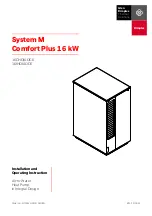
60
SERVICING
NOTE: Check that the air flow is correct before adjusting
charge.
5. With the system still running, remove hose and
reinstall both valve caps.
6. Check system for leaks.
Due to their design, Scroll compressors are inherently
more tolerant of liquid refrigerant.
NOTE: Even though the compressor section of a Scroll
compressor is more tolerant of liquid refrigerant,
continued floodback or flooded start conditions may
wash oil from the bearing surfaces causing premature
bearing failure.
S-104 Checking Compressor Efficiency
The reason for compressor inefficiency is broken or
damaged suction and/or discharge valves, or scroll
flanks on Scroll compressors, reducing the ability of the
compressor to pump refrigerant vapor.
The condition of the valves or scroll flanks is checked in the
following manner.
1. Attach gauges to the high and low side of the system.
2. Start the system and run a Cooling Performance Test.
If the test shows-
• Below
normal high side pressure.
•
Above normal low side pressure.
• Low
temperature difference across coil.
• Low
amp draw at compressor.
-and the charge is correct. The compressor is faulty -
replace the compressor.
S-104 Checking Compressor Efficiency
The reason for compressor inefficiency is broken or
damaged scroll flanks on Scroll compressors, reducing the
ability of the compressor to pump refrigerant vapor.
During the “OFF” cycle, the high side pressure bleeds to
the low side through the fixed orifice restriction device.
Check equalization time as follows:
1. Attach a gauge manifold to the suction and liquid line
dill valves.
2. Start the system and allow the pressures to stabilize.
3. Stop the system and check the time it takes for the
high and low pressure gauge readings to equalize.
If it takes more than seven (7) minutes to equalize, the
restrictor device is inoperative. Replace, install a liquid line
drier, evacuate and recharge.
S-106 Overfeeding
Overfeeding by the expansion valve results in high suction
pressure, cold suction line, and possible liquid slugging of
the compressor.
If these symptoms are observed:
1. Check for an overcharged unit by referring to the
cooling performance charts in the spec sheet manual.
2. Check the operation of the power element in the
valve as explained in S-110 Checking Expansion Valve
Operation.
3. Check for restricted or plugged equalizer tube.
S-108 Superheat
NOTE: Check proper air flow before proceeding.
Checking Superheat
Refrigerant gas is considered superheated when its
temperature is higher than the saturation temperature
corresponding to its pressure. The degree of superheat
equals the degrees of temperature increase above
the saturation temperature at existing pressure. See
Temperature - Pressure Chart .
CAUTION
To prevent personal injury, carefully connect and
disconnect manifold gauge hoses. Escaping liquid
refrigerant can cause burns. Do not vent refrigerant
to atmosphere. Recover during system repair
or final unit disposal.
1. Run system at least 10 minutes to allow pressure to
stabilize.
2. Temporarily install thermometer on suction (large)
line near compressor with adequate contact and
insulate for best possible reading.
3. Refer to the superheat table provided for proper
system superheat. Add charge to lower superheat or
recover charge to raise superheat.
Superheat Formula = Suct. Line Temp. - Sat. Suct. Temp.
Summary of Contents for DRG0361DL00001S
Page 20: ...20 SYSTEM OPERATION...
















































